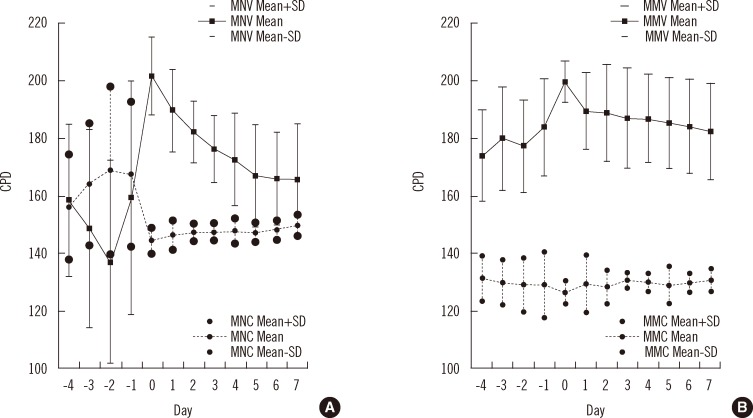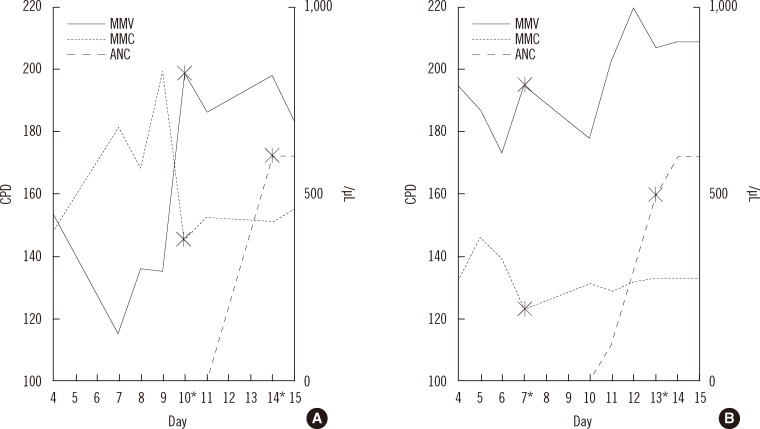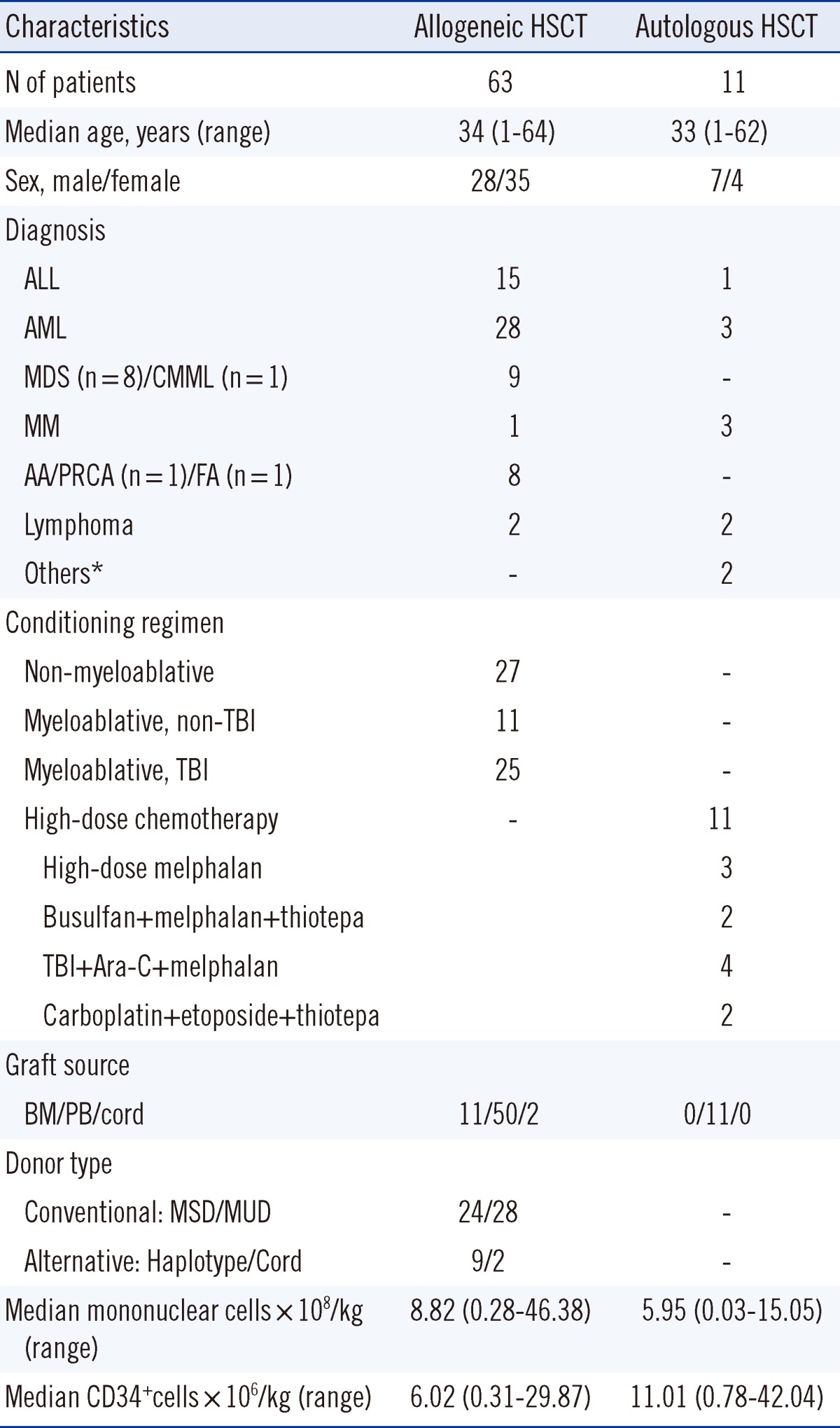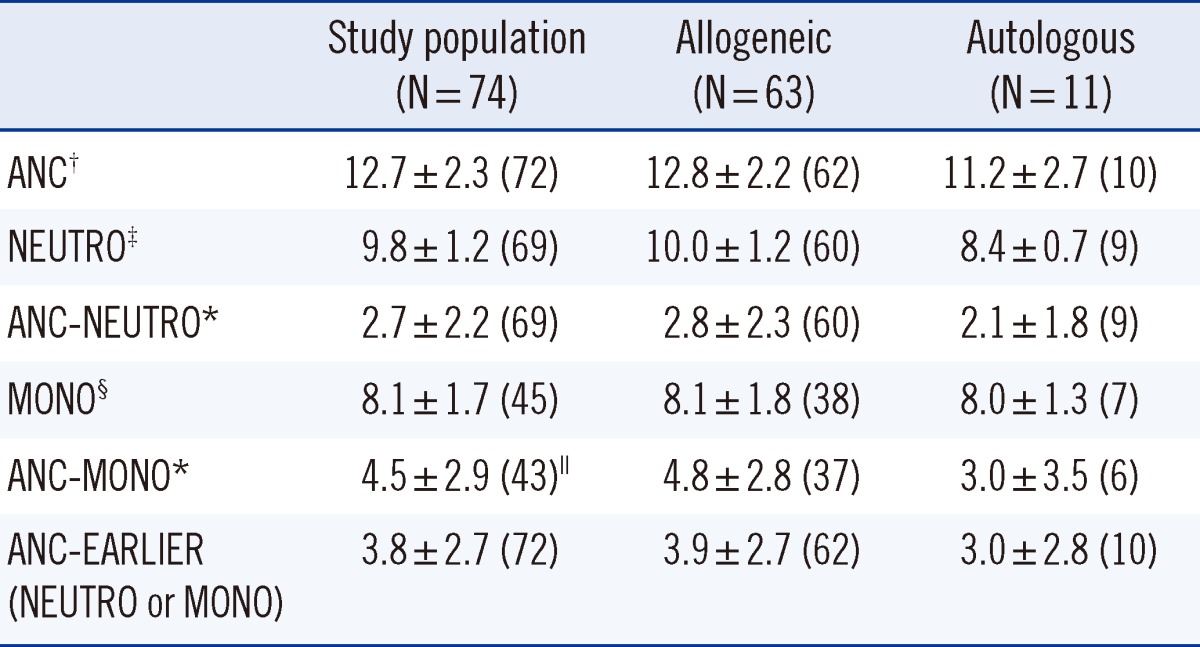1. Clift RA, Buckner CD, Thomas ED, Bensinger WI, Bowden R, Bryant E, et al. Marrow transplantation for chronic myeloid leukemia: a randomized study comparing cyclophosphamide and total body irradiation with busulfan and cyclophosphamide. Blood. 1994; 84:2036–2043. PMID:
8081005.

2. Noronha JF, De Souza CA, Vigorito AC, Aranha FJ, Zulli R, Miranda EC, et al. Immature reticulocytes as an early predictor of engraftment in autologous and allogeneic bone marrow transplantation. Clin Lab Haematol. 2003; 25:47–54. PMID:
12542442.

3. Flowers CR, Seidenfeld J, Bow EJ, Karten C, Gleason C, Hawley DK, et al. Antimicrobial prophylaxis and outpatient management of fever and neutropenia in adults treated for malignancy: American Society of Clinical Oncology clinical practice guideline. J Clin Oncol. 2013; 31:794–810. PMID:
23319691.

4. Phillips R, Hancock B, Graham J, Bromham N, Jin H, Berendse S. Prevention and management of neutropenic sepsis in patients with cancer: summary of NICE guidance. BMJ. 2012; 345:e5368. PMID:
22993392.

5. Grazziutti ML, Dong L, Miceli MH, Cottler-Fox M, Krishna SG, Fassas A, et al. Recovery from neutropenia can be predicted by the immature reticulocyte fraction several days before neutrophil recovery in autologous stem cell transplant recipients. Bone Marrow Transplant. 2006; 37:403–409. PMID:
16400338.

6. Storek J, Geddes M, Khan F, Huard B, Helg C, Chalandon Y, et al. Reconstitution of the immune system after hematopoietic stem cell transplantation in humans. Semin Immunopathol. 2008; 30:425–437. PMID:
18949477.

7. Lee HK, Kim SI, Chae H, Kim M, Lim J, Oh EJ, et al. Sensitive detection and accurate monitoring of Plasmodium vivax parasites on routine complete blood count using automatic blood cell analyzer (DxH800(TM)). Int J Lab Hematol. 2012; 34:201–207. PMID:
22074115.

8. Lee JC, Ahern TP, Chaves FP, Quillen K. Utility of hematologic and volume, conductivity, and scatter parameters from umbilical cord blood in predicting chorioamnionitis. Int J Lab Hematol. 2010; 32:351–359. PMID:
19793112.

9. Mardi D, Fwity B, Lobmann R, Ambrosch A. Mean cell volume of neutrophils and monocytes compared with C-reactive protein, interleukin-6 and white blood cell count for prediction of sepsis and nonsystemic bacterial infections. Int J Lab Hematol. 2010; 32:410–418. PMID:
19919621.

10. Park DH, Park K, Park J, Park HH, Chae H, Lim J, et al. Screening of sepsis using leukocyte cell population data from the Coulter automatic blood cell analyzer DxH800. Int J Lab Hematol. 2011; 33:391–399. PMID:
21338473.

11. Thomas ED, Storb R, Clift RA, Fefer A, Johnson L, Neiman PE, et al. Bone-marrow transplantation (second of two parts). N Engl J Med. 1975; 292:895–902. PMID:
235092.
12. Begemann PG, Hassan HT, Kröger N, Krüger W, Kabisch H, Zander AR. Correlation of time to platelet engraftment with amount of transplanted CD34+CD41+ cells after allogeneic bone marrow transplantation. J Hematother Stem Cell Res. 2002; 11:321–326. PMID:
11983103.
13. Chae YS, Jeon SB, Sung WJ, Lim JW, Kim DH, Kim JG, et al. Clinical outcomes according to transplanted CD34+cell dose in allogeneic peripheral blood stem cell transplantation. Korean J Hematol. 2003; 38:24–31.
14. Borzy MS, Magenis E, Tomar D. Bone marrow transplantation for severe combined immune deficiency in an infant with chimerism due to intrauterine-derived maternal lymphocytes: donor engraftment documented by chromosomal marker studies. Am J Med Genet. 1984; 18:527–539. PMID:
6383041.

15. Rothberg PG, Gamis AS, Baker D. Use of DNA polymorphisms to monitor engraftment after allogeneic bone marrow transplantation. Clin Lab Med. 1997; 17:109–118. PMID:
9138894.

16. Dubovsky J, Daxberger H, Fritsch G, Printz D, Peters C, Matthes S, et al. Kinetics of chimerism during the early post-transplant period in pediatric patients with malignant and non-malignant hematologic disorders: implications for timely detection of engraftment, graft failure and rejection. Leukemia. 1999; 13:20592060–2069. PMID:
10602430.

17. Kim HY, Kim HJ, Ki CS, Kim DW, Yoo KH, Kang ES. Rapid determination of chimerism status using dihydrorhodamine assay in a patient with X-linked chronic granulomatous disease following hematopoietic stem cell transplantation. Ann Lab Med. 2013; 33:288–292. PMID:
23826567.









 PDF
PDF ePub
ePub Citation
Citation Print
Print


 XML Download
XML Download